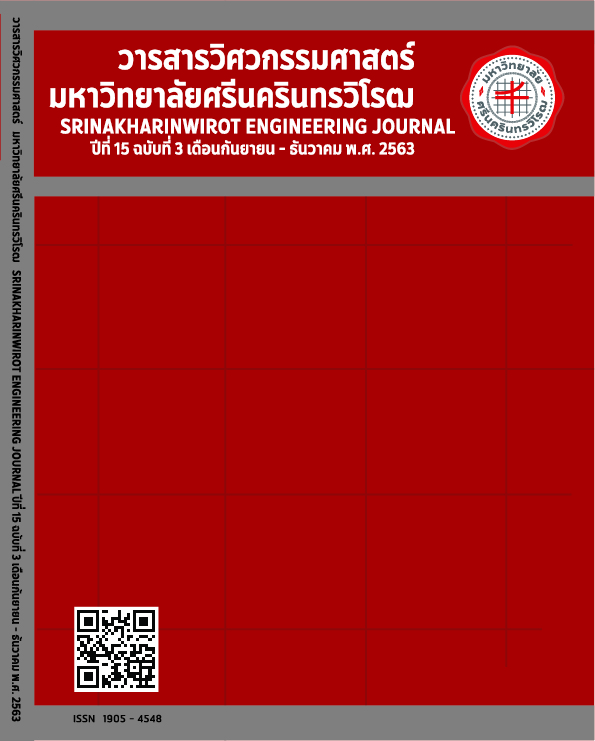Reducing Defect in Plastic Injection Process of Telephone Part By Design of Experiment
Main Article Content
Abstract
This research aimed to reduce the proportion of defect from plastic injection molding process for new part production by using Design of Experimental and applying Quality Control Tools. According to historical data, the proportion of defect was 8,947 ppm, exceeding the company target of 3,000 ppm. The research started with finding problems in the production process using QC Tools. It was found that the silver streak was the highest number of defects, 95.70 % of all defects. And the problem analysis, it was found that the main cause of the problem was the inappropriate parameter settings consisting of 8 factors in the plastic injection molding process. The design of experimental technique by 28-3 Fractional Factorial was then applied in screening experiment to find out the main factors affecting the silver streaks. It was found that there were 4 factors including injection pressure, clamping force, nozzle temperature, and injection speed. The Response Surface Methodology technique by Central Composite Design was then applied for analyzing the response optimization. It was found that suitable parameters included the injection pressure of 97 Mpa, the clamping force of 240 tons, the nozzle temperature of 237 °C, and the injection speed at 30 mm/sec. The research result showed that the applied optimal parameters could reduce the silver streak defects of the part number 1220402 from 33,748 ppm to 6,778 ppm. Moreover, the overall average defect proportions of new part production decreased from 8,947 ppm to 2,320 ppm that were 74.06% of all defects. This achieved the company target which aimed to have less than 3,000 ppm defects.
Article Details
Copyright belongs to Srinakharinwirot University Engineering Journal
References
A. Jit-aree, S. Jarupinyo and R. Kanchana,“Design of Experiments for Analyzing Factors Affecting to Varied Deformation in the Simulation of ABS Plastic Injection Molding Process”, in The 2ndTNIAC: Thai-Nichi Institute of Technology Academic Conference, Bangkok, 2013, pp. 68-73.
P. Chutima, Design of an Engineering Experiment. Bangkok: The Publisher of Chulalongkorn University, 2002, pp. 449-495.
B. Sornnil, Plastic Technology. Bangkok: Technology promotion (Thai-Japanese), Association, 2010, pp. 14-24.
ABS Resin. TOYOLAC Technical Guide Toray Plastics (Malaysia) Sdn. Bnd [Online]. Availiable:https://www.torayplastics.com.my/pdf/toyolac/Technical_guide/GP_Technical_Guide. pdf
W. Techawinyuatham, Plastic injection Engineering. 1st edition, Bangkok: Technology promotion (Thai-Japanese), Association, 2010.
K. Ployphanichcharoan, Quality Control System (QC CIRCLE). Bangkok: The Publisher of S. Asia press co ., ltd. , 2000, pp. 209-312.
P. Suthat Na Ayudhya and P. Luengphaibun, Design and analysis of Experiments. Bangkok: Top, 2008, pp. 281-282.
Douglas C. Montgomery. Design and Analysis of Experiments. The United States of America : John Wiley & Sons, INC., 2005, pp. 478-540.
A. Jit-aree “Experimental design for the analysis of factors influencing deformation in the simulation of ABS plastic injection molding process,” M.S.Thesis, Dept. Industrial Eng., Rajamangala Univ. of Technology Thanyaburi, 2012.
P. Bourtone and W. Sriseubsai,“ Applications of Design of Experiment and Computer-Aided Engineering to Minimize Shrinkage of a Plastic Injection-molded Part” in IE Network conference, Phetchaburi, 2012, pp. 829-834.
K. Chasuriyakul, W. Thasana and T. Khajifa, “Study of heating and cooling temperature of injection molding to effect on gloss of plastic injection parts,” in The 8th TSME International Conference on Mechanical Engineering, Bangkok, 2017, pp. 1238-1246.


